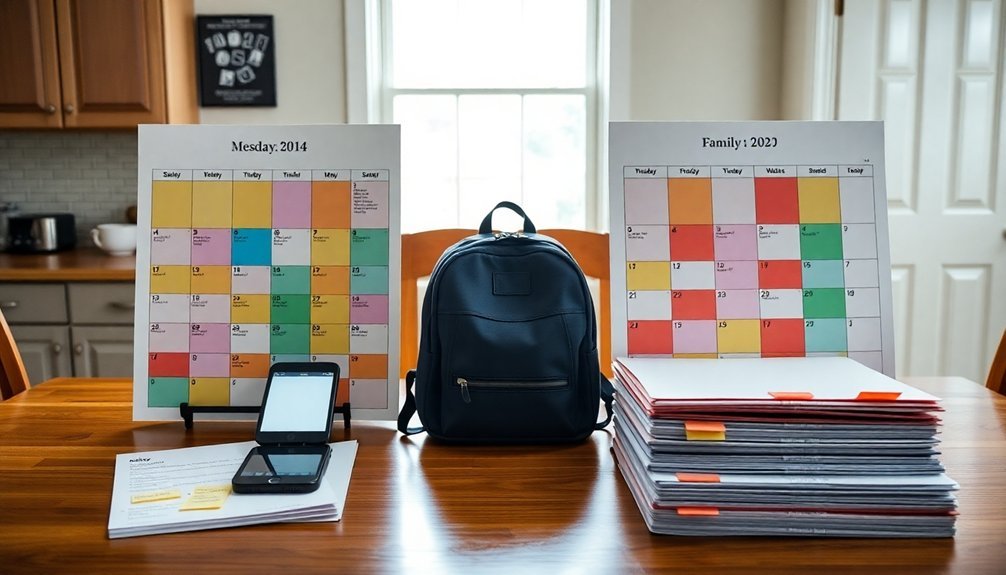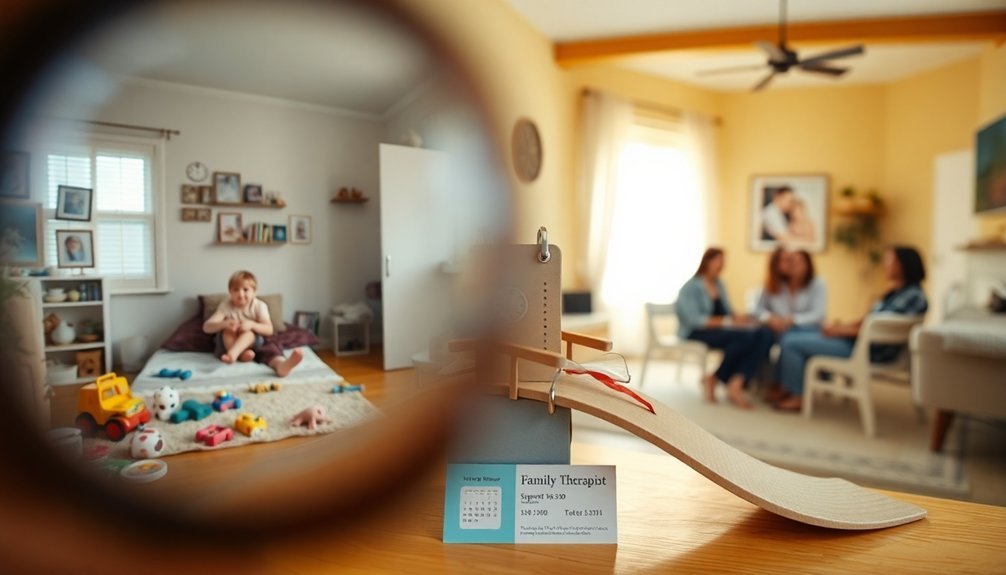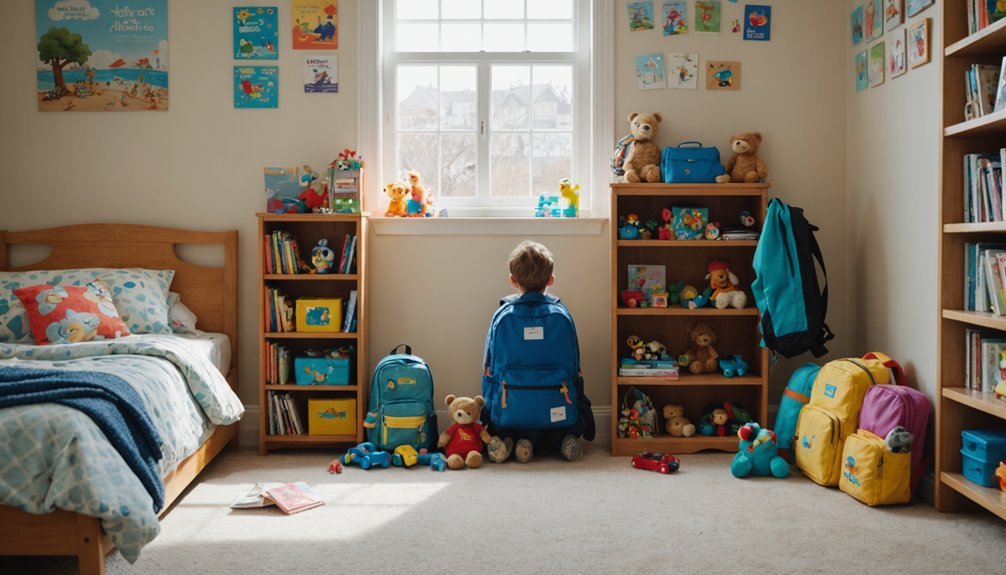If you're traversing the turbulent waters of high-conflict co-parenting, you're likely familiar with the emotional toll it takes on everyone involved. While you can't control your ex-partner's behavior, you can master strategies to protect your peace and prioritize your children's well-being. From establishing iron-clad boundaries to implementing effective communication protocols, there's a proven path forward that doesn't require constant confrontation. As you face this challenging journey, you'll discover that surviving isn't your only option – with the right tools and approach, you can create a sustainable framework for managing even the most difficult co-parenting situations.
Key Takeaways
- Establish written-only communication through co-parenting apps or email to maintain emotional distance and create documentation of all interactions.
- Practice emotional detachment by using businesslike communication and avoiding personal topics unrelated to children's needs.
- Document all interactions, agreements, and concerning incidents in an organized system for legal protection and pattern recognition.
- Create consistent routines across households while protecting children from conflict by never discussing legal matters or personal grievances.
- Build a support network including therapists, mediators, and support groups to maintain emotional stability and receive professional guidance.
Understanding High-Conflict Co-Parenting Dynamics
Co-parenting relationships marked by high conflict can create significant emotional strain and behavioral challenges for everyone involved. When you're dealing with a high-conflict co-parent, you'll often notice patterns of hostility, poor communication, and an inability to separate past relationship issues from current co-parenting roles.
Understanding conflict triggers is essential for managing these dynamics. You might find that shifts between homes, disagreements about schedules, or differences in parenting styles consistently spark confrontations.
It's important to recognize that high-conflict situations rarely emerge from a single source but typically stem from unresolved emotions, power struggles, and differing expectations about child-rearing.
You're not alone if you notice that your co-parent regularly undermines your authority, refuses to compromise, or uses your children as messengers. These behaviors often indicate deeper issues that require professional intervention.
Setting Clear Boundaries

Setting effective boundaries in high-conflict co-parenting starts with establishing clear communication rules that protect your emotional well-being and maintain focus on your children's needs.
You'll benefit from limiting discussions to child-related matters only and choosing specific communication methods, such as email or co-parenting apps, that help maintain emotional distance.
It's essential to document all interactions and agreements in writing, as this creates a clear record of decisions and helps prevent future disputes or misunderstandings.
Communication Rules and Limits
Clear boundaries serve as the foundation for managing high-conflict co-parenting relationships.
When you're dealing with a challenging co-parent, establishing specific communication rules can help minimize tension and create a more manageable environment for everyone involved.
Different communication styles require different approaches, but the goal remains consistent: maintaining a businesslike, child-focused dialogue while protecting your emotional well-being.
To improve your conflict resolution skills and maintain healthy boundaries, implement these essential communication rules:
- Limit communication methods to written formats (email, parenting apps) to maintain a documented record and reduce emotional reactions.
- Set specific response timeframes (24-48 hours) for non-emergency matters to avoid constant interruptions and anxiety.
- Use the BIFF method (Brief, Informative, Friendly, Firm) in all communications to stay focused on facts and solutions.
- Restrict discussions to child-related topics only, avoiding personal matters or past relationship issues.
Document Everything in Writing
Documentation serves as your protective shield in high-conflict co-parenting situations. When you maintain detailed records of all interactions, you're creating an accurate timeline that can protect your interests and help avoid misunderstandings.
Start by establishing a dedicated email address specifically for co-parenting communications, ensuring all exchanges are automatically archived and time-stamped.
Keep meticulous communication logs that include dates, times, and summaries of all interactions, whether they're in person, by phone, or through text messages. When documenting conversations, stick to facts rather than emotional interpretations. Include specific details about agreements, schedule changes, and decisions regarding your children's care, education, and health.
Remember to save screenshots of text messages and maintain folders for email documentation organized by date and topic. If you're using a co-parenting app, utilize its built-in documentation features.
When writing emails or messages, assume that a judge might read them someday – keep your tone professional and focused on your children's well-being. This approach isn't about building a case against your co-parent; it's about creating clarity and accountability in your shared parenting journey.
Managing Emotional Triggers

When co-parenting triggers intense emotional responses, recognizing and managing these reactions becomes essential for maintaining a healthy environment for your children. Through emotional regulation techniques and trigger identification strategies, you can better navigate challenging interactions with your co-parent while preserving your well-being.
Understanding your emotional triggers allows you to respond thoughtfully rather than react impulsively. You're not alone in experiencing these challenges, and developing awareness is the first step toward positive change.
- Practice self-awareness by keeping a trigger journal to identify patterns in your emotional responses.
- Implement calming techniques like deep breathing or progressive muscle relaxation before responding to triggering situations.
- Establish healthy boundaries by developing scripts for difficult conversations with your co-parent.
- Create a personal timeout protocol when you feel overwhelmed by emotions.
Remember that managing triggers isn't about suppressing emotions but rather processing them appropriately.
Consider working with a therapist who specializes in co-parenting conflicts to develop personalized coping strategies. By focusing on your emotional regulation, you'll be better equipped to maintain composure during challenging interactions and model healthy behavior for your children.
Effective Communication Tools

Building on your emotional regulation skills, mastering specific communication tools can transform difficult co-parenting exchanges into more productive interactions.
When communicating with your co-parent, employ active listening techniques by focusing solely on their message without planning your response. This helps reduce misunderstandings and shows respect, even during disagreements.
Practice using "I" statements to express your needs and concerns without triggering defensiveness. Instead of saying "You never follow the schedule," try "I feel worried when pickup times change without advance notice."
Combine this with empathetic responses that acknowledge your co-parent's perspective, even if you disagree.
Keep written communications brief, factual, and child-focused. Use business-like language in emails and texts, and stick to discussing parenting matters only.
Consider using co-parenting apps that document all exchanges and help maintain professional boundaries. When face-to-face, maintain a neutral tone and body language, focusing on solutions rather than past grievances.
Protecting Children From Conflict

Children caught in high-conflict co-parenting situations often experience significant emotional distress that can impact their development and well-being.
Your commitment to protecting your child's emotional safety starts with recognizing how adult conflicts affect their sense of security and stability.
To create conflict-free environments and shield your children from co-parenting tensions, implement these essential strategies:
- Never discuss legal matters, financial disputes, or negative feelings about your co-parent in front of or within earshot of your children, even if you think they're not listening.
- Maintain consistent routines and boundaries across both households while respecting your child's need to love and maintain relationships with both parents.
- Watch for signs of emotional distress, such as withdrawal, aggressive behavior, or academic struggles, and seek professional support when needed.
- Create a "neutral zone" during child exchanges, keeping interactions brief and focused solely on necessary information about your child's care.
Legal Documentation Best Practices

Maintaining thorough records of all communications with your co-parent will protect you legally and help establish patterns of behavior if needed for court proceedings.
You'll want to create a well-organized digital or physical filing system for texts, emails, custody schedules, and any written agreements between both parties.
It's crucial to document pick-up and drop-off interactions, noting dates, times, and any concerning incidents that occur during these exchanges.
Document All Communications
The careful documentation of all communications with your co-parent serves as a crucial shield in high-conflict situations. By maintaining detailed communication logs, you're creating a reliable record that can protect your interests and support your position if legal intervention becomes necessary.
Documenting interactions helps establish patterns of behavior and guarantees you're maintaining a factual account of all exchanges.
When documenting communications with your co-parent, follow these essential practices:
- Record all exchanges in a dedicated digital folder or notebook, including dates, times, and the specific content of conversations.
- Save screenshots of text messages, emails, and social media interactions, storing them in a secure cloud-based location.
- Note the tone and context of interactions, particularly when threats or hostile language are used.
- Maintain a separate log of canceled visits, schedule changes, or any deviations from court-ordered arrangements.
Remember that your documentation should remain objective and fact-based. You're not just protecting yourself; you're creating a clear narrative of your co-parenting journey that can help facilitate better outcomes for your children.
When documenting, focus on recording events without emotional commentary.
Keep Organized Filing System
Building on your documentation efforts, an organized filing system becomes your foundation for managing legal and co-parenting records effectively.
You'll need both physical and digital storage solutions to maintain a thorough record of your co-parenting journey. Create separate folders for court documents, communication logs, medical records, and school-related materials.
For digital storage, establish a cloud-based system that's password-protected and regularly backed up. Sort your emails, text messages, and other electronic communications into clearly labeled folders by date and topic.
Consider using file-naming conventions that make documents easily searchable, such as "YYYY-MM-DD_DocumentType_Description." Keep scanned copies of all important paper documents in your digital archive.
In your physical filing system, use color-coded folders and maintain a master index of contents. Store original documents in a fireproof safe or safety deposit box, keeping copies in your working files.
Remember to date every document you receive or create, and maintain a chronological log of when items are added to your files. This systematic approach guarantees you'll quickly locate any document when needed for legal proceedings or co-parenting discussions.
Record Exchange Interactions
Proper documentation of child exchanges serves as critical evidence in high-conflict co-parenting situations. During these challenging times, maintaining detailed interaction logs can protect your interests and provide clarity when disagreements arise.
Your record keeping should focus on factual observations rather than emotional responses, creating a clear timeline of events that could prove invaluable in legal proceedings.
To effectively document your exchanges, follow these essential practices:
- Record the date, time, and location of each exchange, including any delays or no-shows.
- Note the physical and emotional state of your child during changes, focusing on observable behaviors.
- Document any witnesses present and save any relevant text messages, emails, or communication app exchanges.
- Maintain a digital backup of all records, organizing them chronologically for easy reference.
When recording interactions, remain objective and professional. You'll want to stick to describing what happened rather than interpreting motives or adding personal commentary.
Remember that your documentation may be reviewed by legal professionals, so maintain a tone that reflects your commitment to your child's well-being while demonstrating your reliability as a co-parent.
Creating Parallel Parenting Plans

When communication breaks down between co-parents, parallel parenting plans offer a structured approach to minimize conflict while maintaining each parent's involvement in their child's life.
While traditional co-parenting relies on frequent interaction, parallel parenting intentionally reduces direct contact between parents who struggle with conflict resolution.
To create an effective parallel parenting plan, you'll need to establish clear boundaries and detailed protocols. Start by mapping out separate responsibilities for each parent during their designated time.
You're fundamentally creating two distinct parenting styles that operate independently yet serve your child's best interests.
Include specific guidelines for:
- Drop-off and pickup procedures with minimal interaction
- Communication methods (email only, parent coordination apps)
- Decision-making authority during each parent's time
- Medical and school information sharing protocols
- Emergency contact procedures
- Holiday and special event scheduling
Remember to document everything in writing and have the plan reviewed by legal professionals.
While parallel parenting isn't the ideal long-term solution, it provides a framework for you to parent effectively while working through high-conflict situations.
Focus on maintaining consistency in your approach and keeping your child's needs at the forefront.
Building Support Systems

A strong support system serves as your foundation while maneuvering high-conflict co-parenting situations. Building a thorough support network helps you maintain emotional stability and access valuable resources when challenges arise.
You'll find that combining professional guidance with personal connections creates a well-rounded system of support that sustains you through difficult times.
Consider these essential components when building your support system:
- Professional Resources: Connect with family therapists, mediators, and counselors who specialize in high-conflict co-parenting for expert guidance and coping strategies.
- Family Involvement: Engage trusted family members who can provide emotional support and practical help with childcare or transportation needs.
- Community Integration: Tap into local services, support groups, and parenting workshops that offer both education and peer connection opportunities.
- Online Support: Join moderated online forums and virtual peer groups where you can share experiences, gather advice, and find understanding from others facing similar challenges.
Remember that friend support plays a vital role, but choose confidants wisely.
Select those who'll remain neutral and constructive rather than escalating conflicts. Your support network should empower you to maintain boundaries while focusing on your children's well-being.
Self-Care During Difficult Times

When you're maneuvering through high-conflict co-parenting, it's crucial to establish firm emotional boundaries that protect your mental well-being and prevent others' negativity from overwhelming you.
You'll find strength in developing personal peace rituals, whether that's a morning meditation, an evening walk, or a quiet moment with a journal.
These intentional practices help you maintain emotional equilibrium and create a sanctuary of calm amid co-parenting challenges.
Maintaining Emotional Boundaries
Emotional resilience plays an essential role in managing high-conflict co-parenting situations. When dealing with a challenging co-parent, maintaining healthy emotional boundaries helps protect your well-being and creates a stable environment for your children.
Practicing emotional detachment doesn't mean you're uncaring; it means you're choosing to respond rather than react to provocative situations. Understanding and implementing boundary reinforcement requires consistent practice and self-awareness.
You'll find that establishing clear limits helps reduce stress and prevents emotional manipulation. Creating distance from unnecessary conflict allows you to focus on what truly matters – your children's well-being.
- Establish communication protocols (specific times, methods, and topics for discussion)
- Respond only to child-related matters, avoiding personal debates or historical grievances
- Create a mental "emotional shield" before engaging with your co-parent
- Document interactions while maintaining professional tone and language
Create Personal Peace Rituals
Managing high-conflict co-parenting situations requires more than just setting boundaries – it demands intentional self-care practices to restore your inner calm.
Creating personal peace rituals can serve as your anchor during turbulent interactions and emotional challenges with your co-parent.
Start by establishing a morning ritual that includes mindfulness practices like deep breathing or meditation. You'll find that setting aside just 10 minutes before checking messages from your co-parent can help you approach communications with greater composure.
Incorporate daily affirmations that remind you of your worth and capabilities as a parent, such as "I choose peace over conflict" or "I am a stable presence for my children."
Design an after-interaction routine to help you decompress. This might include a short walk, journaling about your feelings, or practicing progressive muscle relaxation.
When tensions escalate, you'll benefit from having these established rituals to return to.
Remember that these aren't just self-care activities – they're essential tools that help you maintain your emotional equilibrium and model healthy coping strategies for your children.
When to Seek Professional Help

Through the challenging journey of high-conflict co-parenting, recognizing the right time to seek professional help can be essential for your family's well-being. When communication breaks down repeatedly or emotional distress becomes overwhelming, professional intervention can provide the structured support you need. Support groups and therapy options offer valuable resources tailored to your specific situation.
Consider seeking professional help when you notice these warning signs:
- You're experiencing persistent anxiety or depression that affects your ability to parent effectively.
- Your children show signs of emotional distress, behavioral changes, or academic difficulties.
- Attempts at communication with your co-parent consistently result in conflict or hostility.
- You feel unable to maintain boundaries or enforce parenting agreements.
A mental health professional specializing in high-conflict co-parenting can help you develop effective strategies, process emotions, and create healthier patterns of interaction.
They'll work with you to establish practical solutions while providing a safe space to address underlying issues. Remember, seeking help isn't a sign of weakness—it's a proactive step toward creating a more stable environment for your children and yourself.
Frequently Asked Questions
How Do I Handle a Co-Parent Who Constantly Violates Court-Ordered Schedules?
Document all schedule violations in detail, including dates, times, and any communication exchanges.
Keep your communication strictly business-like through email or a co-parenting app, which creates a clear paper trail.
If violations persist, you'll want to explore legal recourse through your attorney.
Consider requesting a modification hearing or enforcement action.
What Are the Best Apps for Documenting Interactions With a High-Conflict Co-Parent?
You'll find several reliable co-parenting apps that excel at documentation.
OurFamilyWizard and TalkingParents are leading choices, offering court-admissible records of all communications.
AppClose and Custody Connection provide free alternatives with solid documentation tools.
For basic tracking, you can also use Google Calendar with detailed notes.
Remember to save screenshots and back up all records to guarantee you're maintaining a complete history of your co-parenting interactions.
Should I Tell My Child About Their Other Parent's Harmful Behaviors?
Studies show that 65% of children whose parents openly criticize each other experience increased anxiety and depression.
You'll want to protect your child's emotional well-being by avoiding negative talk about their other parent.
From your child's perspective, they're half of each parent, and criticism can damage their self-esteem.
Instead, focus on being their safe space and consider working with a family therapist to help your child process their own experiences and feelings naturally.
How Do I Maintain Composure During Custody Exchanges With a Hostile Co-Parent?
You can stay composed during tense exchanges by practicing emotional regulation before, during, and after the interaction.
Try deep breathing techniques when you're feeling triggered, and keep your focus solely on your child's wellbeing.
It's helpful to have a calm-down routine: count to ten, use positive self-talk, or visualize a peaceful place.
When Is It Appropriate to Modify an Existing Custody Agreement?
You may need to pursue custody changes when there's a significant shift in circumstances affecting your child's well-being.
Common modification criteria include: changes in a parent's living situation, work schedule, or relocation; concerns about the child's safety; or your child's evolving needs as they grow.
It's best to document these changes and consult with a family law attorney before proceeding, as courts typically require substantial evidence to modify existing agreements.
Conclusion
Just as a pilot navigates through turbulent skies with precise instruments and protocols, you'll need specific tools to weather high-conflict co-parenting. You're not alone – studies show that 20-30% of divorcing parents experience high conflict. By implementing boundaries, managing triggers, and maintaining child-focused communication, you're creating a smoother journey. Remember, success isn't measured by perfect cooperation, but by your commitment to providing stability and emotional safety for your children.








0 responses to “High Conflict Co-Parenting: Survival Strategies”
Does setting clear boundaries actually help in high-conflict co-parenting? Or does it just fuel the fire of disagreement?
So, in high-conflict co-parenting, is setting boundaries more effective than clear communication rules? Just wondering, no judgement.
Can we really set clear boundaries when dealing with high conflict co-parenting? Isnt communication the real problem here? Just thinking out loud.